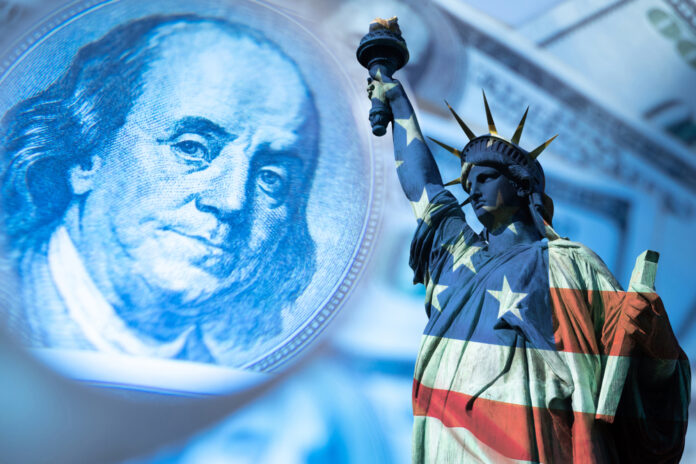The U.S. dollar extended its decline on Tuesday, falling to multi-year lows amid growing expectations of Federal Reserve rate cuts and rising fiscal concerns sparked by President Donald Trump’s spending bill.
By 04:25 ET (08:25 GMT), the U.S. Dollar Index—measuring the greenback against a basket of six major currencies—was down 0.2% at 96.275, marking its lowest level since February 2022.
Dollar Under Pressure
The greenback remains under sustained pressure as markets increasingly price in monetary easing by the Federal Reserve. The prospect of upcoming trade agreements, coupled with political uncertainty over a sweeping tax and spending bill, has further dampened sentiment.
“The dollar continues to grind lower in what’s best described as an orderly bear trend,” analysts at ING noted. “After a structurally driven drop in April, recent declines are more cyclical, driven by shifting Fed expectations.”
Those expectations have intensified as President Trump continues to pressure the Fed, recently sending Chair Jerome Powell a list of global interest rates—marked with handwritten notes suggesting the U.S. rate should fall between Japan’s 0.5% and Denmark’s 1.75%. This political interference has fueled concerns over the Fed’s independence and its long-term credibility, contributing to dollar weakness.
At the same time, markets are wary of internal divisions in the Senate over Trump’s tax and spending bill, which is projected to add $3.3 trillion to the national debt.
“The dollar’s next directional move may hinge on fresh macro data,” ING added, pointing to Tuesday’s ISM manufacturing and JOLTS job openings reports.
Euro Near Four-Year High
In Europe, the euro edged slightly lower, with EUR/USD down 0.1% to 1.1781—just below the four-year high of 1.1808 reached earlier this week. The euro has risen 13.8% in the first half of 2024, marking its strongest-ever H1 performance, according to LSEG data.
Traders await preliminary eurozone inflation data for June, expected to come in at 2.0% y/y, in line with the European Central Bank’s target. Earlier this month, the ECB cut rates for the eighth time in a year but signaled a likely pause, citing trade-related uncertainty.
Manufacturing PMI data for France, Germany, and the broader eurozone are due later in the session, along with remarks from central bank leaders at the ECB forum in Sintra, Portugal.
Sterling Gains Despite Domestic Pressures
The British pound advanced, with GBP/USD rising 0.3% to 1.3764—just shy of last week’s 3.5-year high. However, domestic data showed UK house prices fell by 0.8% in June, the sharpest drop in over two years, according to mortgage lender Nationwide.
Political risk also looms for the pound, as Prime Minister Keir Starmer faces a potential backbench rebellion over proposed welfare reforms. The government has already conceded around £4 billion to push the bill through Parliament, but further resistance could prompt additional concessions—raising fiscal concerns and putting pressure on both sterling and UK government bonds.
Yen Strengthens on Safe-Haven Demand
In Asia, the Japanese yen strengthened on safe-haven flows, with USD/JPY down 0.7% to 143.06. The move followed renewed tensions between Washington and Tokyo after President Trump criticized Japan’s reluctance to purchase U.S.-grown rice and threatened to end trade talks.
Despite the rhetoric, Japanese officials stated Tuesday that negotiations with the U.S. remain ongoing but emphasized that Japan’s agricultural sector would not be sacrificed in any deal.
Yuan Holds Firm on Positive Data
Meanwhile, the Chinese yuan was steady, with USD/CNY slipping slightly to 7.1624—hovering near its strongest level since November. Caixin PMI data released Tuesday showed China’s manufacturing sector returned to expansion in June, supported by a temporary reduction in trade tariffs agreed between Beijing and Washington.



